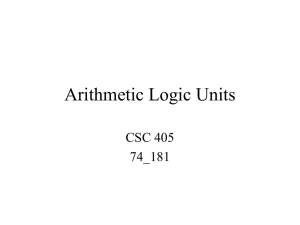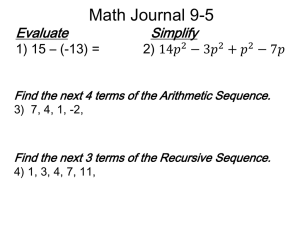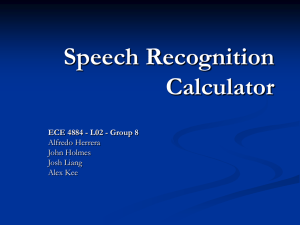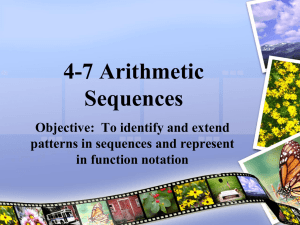lec10
advertisement
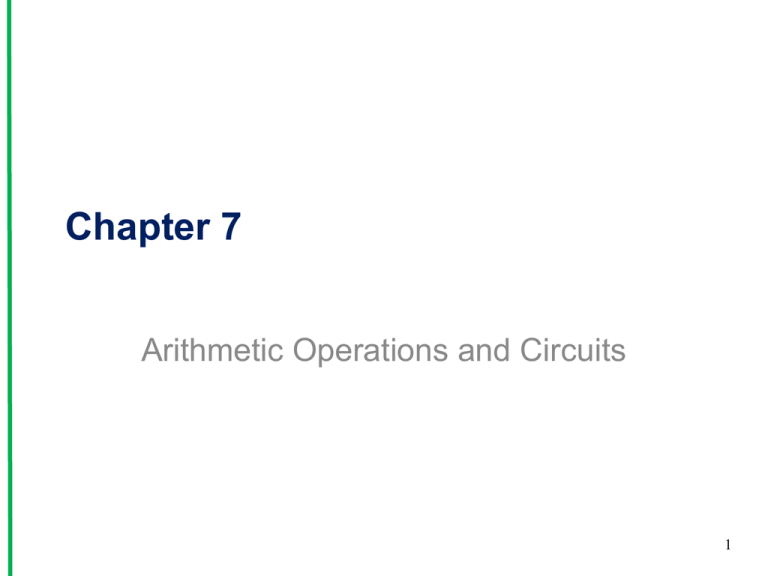
Chapter 7 Arithmetic Operations and Circuits 1 7-4 Hexadecimal Arithmetic • 4 binary bits represent a single hexadecimal digit • Addition – Add the digits in decimal – If sum is less than 16, convert to hexadecimal – Is sum is more than 16, subtract 16, convert to hexadecimal and carry 1 to the next-moresignificant column 23 Example 7-12 Hexadecimal Arithmetic • Subtraction – When you borrow, the borrower increases by 16 – See example 7-15 24 Example 7-15 25 7-5 BCD Arithmetic • Group 4 binary digits to get combinations for 10 decimal digits • Range of valid numbers 0000 to 1001 • Addition – Add as regular binary numbers – If sum is greater than 9 or if carry out generated: • Add 6 (0110) saving any carry out 26 7-6 Arithmetic Circuits • Only two inputs are of concern in the LSB column. • More significant columns must include the carry-in from the previous column as a third input. 27 Arithmetic Circuits • The addition of the third input (Cin) is shown in the truth table below. 27 Arithmetic Circuits • Half-Adder – No carry in (LSB column) – The 0 output is HIGH when A or B, but not both, is high. • Exclusive-OR function – Cout is high when A and B are high. • AND function 28 Arithmetic Circuits • The half-adder can also be implemented using NOR gates and one AND gate. – The NOR output is Ex-OR. – The AND output is the carry. 28 Arithmetic Circuits • Full-Adder – Provides for a carry input – The 1 output is high when the 3-bit input is odd. • Even parity generator – Cout is high when any two inputs are high. • 3 AND gates and an OR 29 Arithmetic Circuits • Full-adder sum from an even-parity generator 32 Arithmetic Circuits • Full-adder carry out function 33 Arithmetic Circuits • Logic diagram of a complete full-adder 34 Arithmetic Circuits • Block diagrams of a half-adder (HA) and a full adder (FA). 35 Arithmetic Circuits • Block diagram of a 4-bit binary adder 36 7-7 Four-Bit Full-Adder ICs • Four full-adders in a single package • Will add two 4-bit binary words plus one carry input bit. 37 Four-Bit Full-Adder ICs • Functional diagram of the 7483 • Note that some manufacturers label inputs A0B0 to A1B3 • The carry-out is internally connected to the carry-in of the next full-adder. 38 Four-Bit Full-Adder ICs • Logic diagram for the 7483. 39 Four-Bit Full-Adder ICs • Logic symbol for the 7483 39 Four-Bit Full-Adder ICs • Fast-look-ahead carry – Evaluates 4 low-order inputs – High-order bits added at same time – Eliminates waiting for propagation ripple 40 7-9 System Design Application • Two’s-Complement Adder/Subtractor Circuit 41 System Design Application • BCD Adder Circuit 42 7-10 Arithmetic/Logic Units • The ALU is a multipurpose device • Available in LSI package • 74181 (TTL) • 74HC181 (CMOS) • Mode Control input – Arithmetic (M = L) – Logic (M = H) 44 Arithmetic/Logic Units • Function Select selects specific function to be performed 45 Summary • The binary arithmetic functions of addition, subtraction, multiplication, and division can be performed bit-by-bit using several of the same rules of regular base 10 arithmetic. • The two’s-complement representation of binary numbers is commonly used by computer systems for representing positive and negative numbers. 48 Summary • Two’s-complement arithmetic simplifies the process of subtraction of binary numbers. • Hexadecimal addition and subtraction is often required for determining computer memory space and locations. • When performing BCD addition a correction must be made for sums greater than 9 or when a carry to the next more significant digit occurs. 49 Summary • Binary adders can be built using simple combinational logic circuits. • A half-adder is required for addition of the least significant bits • A full-adder is required for addition of the more significant bits. 50 Summary • Multibit full-adder ICs are commonly used for binary addition and two’s-complement arithmetic. • Arithmetic/logic units are multipurpose ICs capable of providing several different arithmetic and logic functions. • The logic circuits for adders can be described in VHDL using integer arithmetic. 51 Summary • The Quartus II software provides 7400-series macrofunctions and a Library of Parameterized Modules (LPMs) to ease in the design of complex digital systems. • Conditional assignments can be made using the IF-THEN-ELSE VHDL statements. 51
